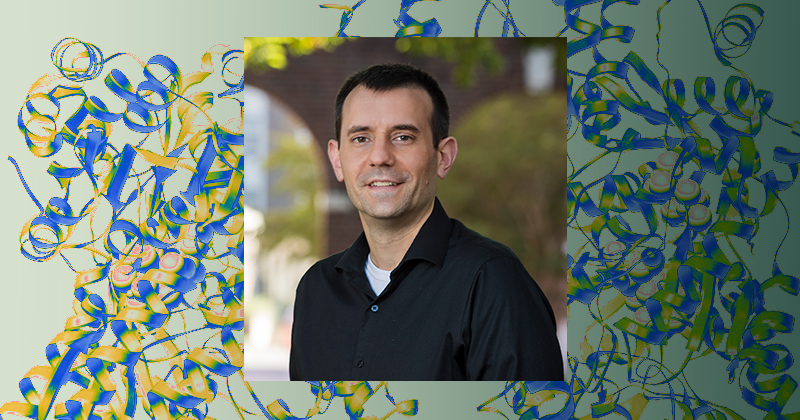


Understanding How Nature Does Chemistry
Photo and illustration by Jeffrey C. Chase August 13, 2024
UD biochemist Jeffrey Mugridge receives National Science Foundation CAREER award to explore how metalloenzymes work and impact disease
Before a train can transport people or goods from one location to another, the railroad engineer must couple the railcars together in the proper order. On a passenger train, for example, this might include first-class cars, commuter cars, quiet cars or dining cars.
In our cells, small ribonucleic acid molecules called transfer RNA (tRNA) play a similar role, ferrying molecules called amino acids to the ribosome, the molecular machinery in our bodies that makes proteins.
Proteins are the building blocks of life. They are made when a string of amino acids is connected in the correct order. These proteins then live inside our cells and perform all sorts of functions that help us live our daily lives.
Biological catalysts called enzymes sometimes chemically modify our tRNA at different locations, which can be important for how the tRNA does its job. In some cases, the lack of these modifications can mess up the protein-making process, leading to misfolded proteins, cancers, and even a higher likelihood of developing neurological diseases, such as amyotrophic lateral sclerosis or ALS.
University of Delaware biochemist Jeffrey Mugridge has received a National Science Foundation Faculty Early Career Development award to study a category of enzymes known as metalloenzymes, which use metal atoms to spark these important modifications on tRNA molecules.
The five-year, $820,000 grant will enable Mugridge and his research team to explore the atomic-level details of how these metalloenzymes work to chemically modify tRNA molecules. In a lot of cases, researchers don’t quite know how these enzymes recognize certain tRNAs or how the enzymes’ function is regulated in the cell by interactions with tRNA or with other proteins. Mugridge hopes to define how these enzymes use different metal centers and complex chemistry to install these modifications and to understand better how these enzymes interact with the specific tRNAs that they work on.
Part of the research involves optimizing conditions to get the metalloenzymes to do their work in a test tube, instead of inside the cell, so that Mugridge and his team can perform biochemistry experiments. Mugridge wants to make mutations to different places on the enzyme to systematically dissect how the enzymes function and to capture atomic-level snapshots of the enzymes in action, using structural biology techniques like protein crystallography and cryo-electron microscopy. With metalloenzymes, this can present lots of unique challenges.
“Some of the enzymes we're studying use metals that are air sensitive. If they are isolated in a test tube and air gets in, their metals become oxidized and the enzyme no longer works,” Mugridge explained. Working with these air-sensitive metalloenzymes requires special precautions and techniques to keep oxygen away from the enzyme during experiments so that its metals remain happy and functional.
Understanding how these metalloenzymes work can inform our broader understanding of diseases that develop when people have mutations in those proteins—or even potentially inform drug design to target metalloenzymes when their activity or over-activity is undesirable.
“It's very useful to know, structurally—and chemically—what's happening, so that you can think about different sites or ways to target those enzymes with different drugs,” he said.
Retaining undergraduate students in STEM
As part of the grant, Mugridge plans to develop a course-based undergraduate research experience — or CURE — to involve UD undergraduate students in research. Students who sign up for the course will be given the framework for a real research problem, then work together in groups to develop a hypothesis, design experiments and test their approaches experimentally in the lab.
The course will provide an alternative research experience for students who are curious but may only want to conduct research for a few semesters, due to other course requirements or interests. It could also open eyes—and doors—for students who haven’t yet realized that research is for them.
“Research experiences have been shown to have a positive effect in retaining students of all backgrounds on science pathways,” said Mugridge. “The CURE portion of the proposal can expand the number of undergrads who have research experiences. It also has the capacity to involve local high school students that are underrepresented in science to give them a taste of what scientific research is like.”
Contact Us
Have a UDaily story idea?
Contact us at ocm@udel.edu
Members of the press
Contact us at 302-831-NEWS or visit the Media Relations website

